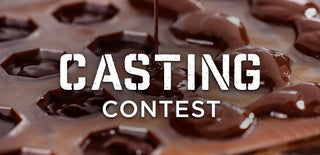Introduction: Your Head Cast in Metal - Photogrammetry > 3D Printing > Metal Casting
In this project, I’ll show how it’s possible to transform your FDM prints into metal, in a simple and inexpensive process.
The possibilities of applying this process are diverse. Even jewelry mechanical parts can be obtained through this method! I hope you like it, I tried to keep it as simple and cheap as possible. This work was developed in the MakerLab of Facamp with my friends’ Gabriel Barboza help, for the casting process, Livia Rocha & Vitor Damiani for Photogametry and Fabio Iori for the correction of the written part.
Step 1: Materials
Safety First!
Protective goggles
Protective gloves
Coat
Closed shoes
Pants
Protective mask with activated carbon filter (heavy metals are toxic!)
For Molding
- Base
- Hot Glue
- Tube
- Silicone for Casting
For Printing
- 3D Printer
- PLA Filament (or Wathever)
For Slicing
- Simplify 3D
For Photogametry
- Camera
- Tripod (if you prefer)
- Autodesk Recap (Free for student)
- A nice friend
For Casting
- Metal with low melting temperature (Lead in this case)
- Torch
- Crucible
- Refractory brick
Step 2: Take the Photos
Autodesk made a video that explains very well all the details you need to know to make a perfect photogametry!
To make your own photogrammetry you will need a good friend, to stand still and to stay awake!
Step 3: Upload Your Photos
With the photos in hand and with the software (Recap) installed, just upload the photos on the server for processing and wait a few minutes until it’s complete (explanatory GIF).
Step 4: Repair Your Model
Once your model is processed by the Autodesk server, you will probably need to make some adjustments, such as deleting some surfaces and closing some holes to close the geometry to be 3D printed.
The video above objectively shows how to do this correction step.
Step 5: Prepare to Print
Now it’s time to print yourself! The piece must be strong enough to be demolded without damaging the mold.
Printing settings
- Slicer: Simplify 3D
- Printer : Sethi3d S3
- Filament : PLA (Ext 210C / Bed 65C)
- Resolution : 0.05mm
- Infill: 15%
- Infill Type: Grid
- Shell: 3
- No Support
- Printing Time : 3h
- Weight: 8g
Step 6: The Print
In this case, I chose not to make any type of finish on the part before making the mold because it was printed on PLA, so sanding could take details of the model. However, it would be perfectly possible to finish it with acetone before making the mold, if the piece was made of ABS.
Step 7: Mold
To make the silicone mold you need a base and a wall, ideally leaving between 1 to 1.5cm between the part and the walls of the mold, to assure consistency and to not waste material. To place and seal the wall and the base, it’s interesting to use hot glue. The sealing is important to avoid any type of leakage.
To prepare the casting silicone, simply follow the information in the packaging. It’s usually enough to mix the silicone and the catalyst in the correct proportions. Wait until the mold solidifies. When the mold has dried, simply cut it on the sides to remove the 3D piece and use a tape to seal it again to the casting.
Step 8: Casting
Casting time! In this step, it’s important to use all the safety equipment. You will work with material at high temperature, and some metals can be toxic because they release heavy metal vapor.
To melt the metal, use a container with a melting temperature higher than the metal to be melted. In this case, we melted lead so the steel can calmly held the flame of our torch. Wait until all the metal is visibly liquid - the time may vary according to the material and the quantity, so be careful. When pouring metal into the mold, look out to not burn yourself or to not drop metal on surfaces that may catch fire. The liquid metal tends to solidify quickly, so do not waste time to fill the mold as it can get stuck inside the can. After casting, just wait for the mold and the part to cool naturally.
Step 9: Unmolding
If all the steps were done correctly, you will have your awesome copy in metal.
Step 10: Voilà!
Enjoy the result and take some pictures!
You can polish your piece if you want, but, personally, I did like the rough look of my piece. If you enjoyed, please favorite my project! You can message me if any question pops up :D

Runner Up in the
Casting Contest











